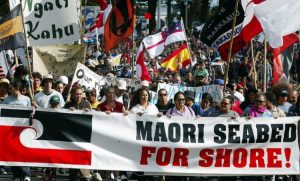Biographical Timeline | Leadership Qualities | N.Z Foreshore and Seabed | References
Barber, David. “Obituary: Dame Whina Cooper.” Independent.co.uk. Last modified March 27, 1994, http://www.independent.co.uk/news/people/obituary-dame-whina-cooper-1432167.html.
Bradley, Michael. “Hikoi Protesters.” Getty Images. Accessed December 7, 2017. http://www.gettyimages.com/license/56089765
“Dame Whina Cooper, 1987.” Nzhistory.gov.nz. Last modified July 07. 2014. https://nzhistory.govt.nz/media/photo/dame-whina-cooper.
Derby, Mark. “Waitangi Tribunal – Te Rōpū Whakamana – Forming the Waitangi Tribunal, 1970s.” http://www.TeAra.govt.nz/en/photograph/32482/maori-land-march-1975. Te Ara – the Encyclopedia of New Zealand (Te Ara – the Encyclopedia of New Zealand, 2012).
“Door Open to Repeal of Foreshore and Seabed Act.” Sharechat. Accessed December 8, 2017. http://www.sharechat.co.nz/article/6ae078b7/door-open-to-repeal-of-foreshore-and-seabed-act-government.html
“Foreshore and Seabed Legislation to be Repealed.” Stuff. Access December 8, 2017. http://www.stuff.co.nz/national/politics/3808252/Foreshore-and-seabed-legislation-to-be-repealed
Keane, Basil. “Ngā rōpū tautohetohe – Māori protest movements – Waitangi Day protests.” http://www.TeAra.govt.nz/en/photograph/35935/whina-cooper-eva-rickard-and-titewhai-harawira. Te Ara – the Encyclopedia of New Zealand. (Te Ara – the Encyclopedia of New Zealand, 2012).
Kenny, Kate. “Women look after yourselves” Stuff. 25 June 2014. http://www.stuff.co.nz/national/women-of-influence/10198114/Women-look-after-yourselves.
King, Michael. “Cooper, Whina.” https://teara.govt.nz/en/biographies/5c32/cooper-whina. Te Ara – the Encyclopedia of New Zealand. (Te Ara – the Encyclopedia of New Zealand, 2000).
“Law of the foreshore and seabed.” Te Ara- the Encyclopedia of New Zealand. Accessed December 8, 2017. https://teara.govt.nz/en/law-of-the-foreshore-and-seabed
Leslie, Brent. “Koha – Nga Pikitia Maori.” last modified 1987. https://www.nzonscreen.com/title/koha-nga-pikitia-maori-1987/overview.
Miller, John. “Whina Cooper at Parliament in Wellington, during Maori Land March.” Photo Histories Exhibition. Accessed December 7, 2017. http://photoforum-nz.org/gallery/captions.php?pageID=23&showID=75
Ministry of Justice. Foreshore and Seabed Act. New Zealand Parliament, 2004.
Ministry of Justice. Marine and Coastal Area (Takutai Moana) Act 2011. New Zealand Parliament, 2011.
Rāwiri Taonui. “Ngāpuhi – Early European contact.” http://www.TeAra.govt.nz/en/photograph/407/a-poem-for-whina-cooper. Te Ara – the Encyclopedia of New Zealand (Te Ara – the Encyclopedia of New Zealand, 2017).


